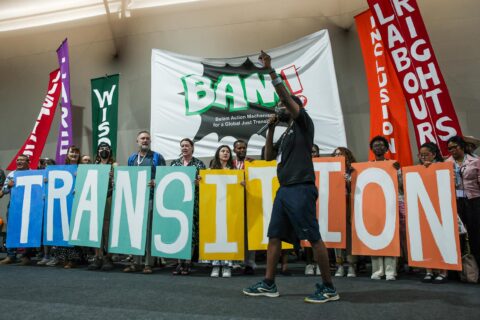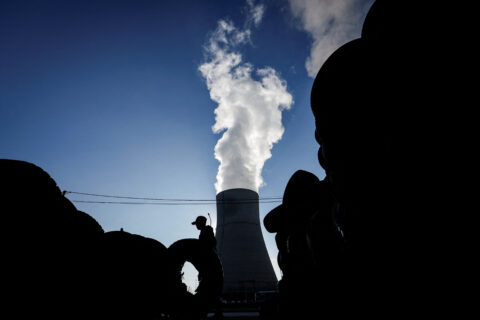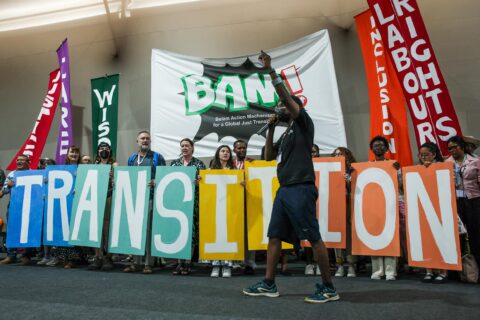Neat rows of new houses with solar panels on their turquoise roofs radiate out from the quiet central square of Aghali, a government-branded “smart village” in south-western Azerbaijan. A path lined with yellow bushes leads to the river, where a state-of-the-art hydropower plant produces clean electricity for residents.
Aghali is a pioneering example of Azerbaijan’s plan for “green” reconstruction of the territories it captured after a long, bloody conflict with Armenia, centred on the disputed Nagorno-Karabakh mountainous enclave.
Hundreds of Azeris displaced from the region in the early 1990s have moved back to Aghali, a local government official told Climate Home.
“The emotional link to these territories is very strong even though 30 years have passed,” the official said. “Our people are happy to be back”.
The government says more than 100,000 Azeris will return to populate the 30 or so new towns and villages planned across the area by 2026, which are expected to run mainly on clean energy and aim for “net zero” emissions.
Yet a more troubled story lies beneath the shiny surface presented by the authorities – part of Azerbaijan’s efforts to polish its green credentials before the COP29 UN climate summit it will host in November.
Some 136,000 ethnic Armenians who had called Nagorno-Karabakh their homeland fled in a mass exodus during a two-part military offensive by Azerbaijan that started in 2020 and ended last autumn.
For Armenian authorities and some human rights and legal experts, the drive amounted to “ethnic cleansing” – a phrase used in a European Parliament resolution on the conflict. A spokesperson for COP29 told Climate Home the Azerbaijan authorities “categorically reject this view”.
With the fighting now over, the two sides are engaged in talks to build a lasting peace. They struck an initial agreement to establish border demarcations in April, but hopes of a swift breakthrough on a permanent solution remain slim.
Meanwhile, displaced Armenians have said publicly they fear the heritage sites and homes they hastily left behind will be erased under a giant construction effort. Evidence of this was seen last month by Climate Home on a press trip organised and sponsored by the COP29 Presidency team, which controlled access to locations and sources in the region.
‘Net zero’ vision
Azerbaijan has built its prowess, both on and off the battlefield, on the strength of its vast oil and gas reserves. Around 60 percent of the government’s budget is financed through the sale of fossil fuels, primarily via export to Europe.
Last month, Azerbaijan President Ilham Aliyev called oil and gas “a gift from God” at the Petersberg Climate Dialogue in Berlin, signalling continued investment in increased gas production. That is despite signing up, like all countries, to a global agreement to transition away from fossil fuels “in keeping with the science” at the COP28 UN climate summit in Dubai last December.
Nonetheless, as its capital Baku gears up to host COP29, Azerbaijan also wants to show off its efforts to adopt clean energy and cut planet-heating emissions to the outside world.
Nagorno-Karabakh, and the surrounding provinces, lie at the centre of this push. The government has declared a “green energy zone” here, adding a dozen hydropower plants, and seeking to attract foreign investment in solar and wind.

Azerbaijan President Ilham Aliyev in front of a screw turbine hydro power plant in Zangilan, one of the territories recaptured in 2020. Photo: Azerbaijan Presidency
Across the country, the government wants renewables to make up 30 percent of its installed electricity capacity by 2030 – up from 7 percent in 2023. The main motivation is to reduce the use of gas in its own power stations so that more of it can be shipped to Europe, President Aliyev said during an event at ADA University in Baku in April.
Azerbaijan is also planning to achieve “net zero” carbon emissions in Karabakh by 2050, as outlined in its latest national climate action plan (NDC) submitted under the UN climate process. It says that “to revitalise the territories liberated from occupation”, the government will establish “smart” settlements, promote “green” energy zones, agriculture and transport, and reforest “thousands of hectares”.
For Anna Ohanyan, a senior scholar in the Russia and Eurasia programme at the US-based Carnegie Endowment for International Peace, “it’s greenwashing of an ethnic cleansing, pure and simple”.
“Azerbaijan is putting a stamp on the territory as a way to legitimise the conquest of Nagorno-Karabakh and doing so under the pretence of helping fight climate change,” she told Climate Home.
The COP29 spokesperson said in emailed comments that this view “has no basis in fact”, adding that Azerbaijan is rebuilding houses for its citizens who were internally displaced during the conflict, “according to UN sustainability standards”.
Disputed territory
Territorial disputes over the Nagorno-Karabakh region have a long and complex history.
“Azerbaijan and Armenia – both are convinced this is historic patrimony of their people,” said Audrey Altstadt, a professor of history at the University of Massachusetts Amherst who specialises in Azerbaijan.
As the Soviet Union set about governing its far-flung provinces in the 1920s, then Commissar of Nationalities, Joseph Stalin, ruled that the region should be part of Soviet Azerbaijan, even though ethnic Armenians made up 94% of its population at the time.
In the 1980s, alongside the fall of the Soviet Union, tensions began to rise after Nagorno-Karabakh’s governing authorities declared their intention to join Armenia and Azerbaijan reacted by attempting to suppress separatists.
After the two sides gained independence from the Soviet Union in 1991, clashes between them escalated into an all-out war.
By the time fighting stopped three years later, Azerbaijan had suffered a crushing defeat, losing not just Nagorno-Karabakh but also a sizable chunk of territory around it. Ethnic Armenians declared a separatist republic in the region with the backing of Armenia.

Evolution of territorial control over Nagorno-Karabakh, and surrounding districts, from the aftermath of the 1994 war until today. Graphic: Fanis Kollias
Some 870,000 Azeris abandoned their homes in the captured area and Armenia itself, while around 300,000 ethnic Armenians fled Azerbaijan, according to the United Nations’ refugee agency.
For 15 years the conflict remained frozen, while international actors – led by the United States, France and Russia – tried, and failed, to find a peaceful resolution.
Azerbaijan’s autocratic president, Aliyev, took matters into his own hands in September 2020, mounting a large-scale military offensive on Nagorno-Karabakh. Powered by more sophisticated weaponry, and backed by Türkiye, Azeri forces prevailed during a 44-day war that claimed the lives of at least 7,000 people – including over 100 civilians.
Under a ceasefire agreement signed in November 2020, Azerbaijan gained a significant proportion of Nagorno-Karabakh, including the coveted town of Shushi – called Shusha by Azeris – as well as winning control of adjacent districts.
Soon afterwards, Baku announced a colossal programme to rebuild and repopulate the region, establishing “green energy zones” in Nagorno-Karabakh and East Zangezur.
Rebuilding ‘from scratch’
Deep behind a string of police checkpoints, the plan is proceeding apace. It includes Aghali, one of the “smart” villages created by the government to accommodate Azeri citizens displaced from the area three decades ago.
“Everything we build here, starting from houses to schools, is based on the element of solar,” said Vahid Hajiyev, special representative of the Azerbaijan presidency in Jabrayil, Gubadli and Zangilan districts, addressing a group of international reporters.
“The whole area had been devastated,” added Hajiyev, saying it was largely abandoned and littered with mines after Armenia captured it. “We’re doing everything from scratch and that gives an opportunity to do it right.”

A view of Aghali, a “smart” village created by the Azerbaijani government in the territories retaken from Armenia, in April 2024. Photo: Matteo Civillini
A nearby screw hydro turbine provides electricity for the whole village, while homes are equipped with solar water heating systems, officials told Climate Home.
“Smart agriculture” projects are being developed to give work to the more than 860 people who, according to government figures, have already moved into the village, with hundreds more expected to join them soon, they added.
Climate Home was not able to talk to any of the residents, besides government officials, and was not shown around the homes.
Aghali offers a template for around 30 similar villages the Azeri government plans to erect across the captured regions. They are just one part of the mammoth construction drive in the Karabakh area, bankrolled by Baku to the tune of just under $2.5 billion a year – around 12% of total public spending.
While the official vision projects an eco-paradise, in Baku’s breakneck drive to put it into practice, the landscape currently resembles a sprawling construction site, as seen by Climate Home and shown by satellite images.
Travelling up the windy road to Shusha-Shushi just before midnight, the headlights of dump trucks and cement mixers pierced the near-total darkness.
They are the backbone of a giant effort to lay down thousands of kilometres of roads and railways and throw up brand-new airports, vast conference halls, hotels and apartments.
Globally, construction is among the most polluting industries, contributing around 10% of global carbon dioxide (CO2) emissions in 2022, according to the UN Environment Programme (UNEP).
In March 2022, the Azerbaijan government invited observers from UNEP to assess the environmental situation in the territories it had gained, after accusing Armenians of large-scale destruction and contamination of the water and soil.
The UNEP team documented “chemical pollution of water” and “deforestation” as a result of activities in dozens of mines and quarries carried out by the Armenian administration “with inadequate environmental oversight and supervision”.
But it also found that Azerbaijan’s building drive, then still in its infancy, was already putting further strains on the environment, as well as causing climate-heating emissions, thereby “adversely impacting the zero-emission goal for the region”.
The construction of new roads was “having a significant impact on forest cover”, its report stated, while the infrastructure programme “placed a significant burden on finite natural raw materials” extracted from local quarries to make cement or asphalt.

The construction drive is altering the landscape in Nagorno-Karabakh. Photo: Matteo Civillini/April 2024
The COP29 spokesperson said Azerbaijan is following the recommendations of the UNEP report and that “a number of mitigation measures have been undertaken” to curb the environmental footprint of the works.
“We believe that the net impact of the reconstruction effort will actually contribute to Azerbaijan’s climate change and decarbonisation goal,” the spokesperson added.
Nagorno-Karabakh’s net zero target has yet to be extended to the rest of the country. Currently Azerbaijan has a goal to reduce emissions 40% by 2050 and has promised to submit a new NDC that is aligned with limiting global warming to 1.5C, which is due by early 2025.
Environmental blockade
In December 2022, environmental concerns became a weapon in the long-running dispute over Nagorno-Karabakh. Azerbaijani eco-activists blocked the Lachin Corridor, the only road connecting the region to the outside world and a vital supply line for food and medicines.
They were ostensibly demonstrating over the impact of mining in the breakaway region. But, according to close watchers of the conflict, the protesters had been sent there by Baku – a claim denied by the COP29 spokesperson.
At the time, one protester told Climate Home that representatives from the Ministry of the Environment were also present. On many other occasions, the Azerbaijan government has cracked down on political dissent, according to human rights groups.
When, four months later, Azerbaijan erected a permanent checkpoint on the road to “prevent the illegal transportation of manpower and weapons”, the sit-in ended. But the blockade of Nagorno-Karabakh continued with only limited amounts of aid trickling in.
Shortages of food, medications and fuel plunged the region into a humanitarian crisis, according to UN human rights experts.
“In the end, it was hard to even find bread. There were women and kids queuing all night for a piece of bread,” recalled Siranush Sargsyan, an Armenian journalist from Nagorno-Karabakh, in an interview with Climate Home. “Even if they didn’t kill all of us, they were basically starving people.”
On September 19 2023, Azeri forces launched a lightning attack on the parts of Nagorno-Karabakh still controlled by ethnic Armenians in what Baku called “an anti-terrorist operation”. Within 24 hours, the de-facto government of the enclave surrendered and announced the republic would cease to exist the following January.
Fearing violence and persecution, over 100,000 ethnic Armenians – nearly the entire remaining population – fled their homes in Nagorno-Karabakh and sought refuge in Armenia.

Refugees from Nagorno-Karabakh region arrive at the Armenian border in a truck in September 2023. REUTERS/Irakli Gedenidze
“[The] liberation of territories was a main goal of my political life. And I’m proud that these goals have been achieved,” President Aliyev, whose family has ruled over Azerbaijan for the past 31 years, said last December. “I think we brought peace. We brought peace by war.”
Now in full control of Nagorno-Karabakh, Azerbaijan is doubling down on its efforts to reshape the region and move tens of thousands of Azeris there. “We will continue the ‘Great Return’ campaign until all those who were forced from their homes can go home,” the COP29 spokesperson said, referring to internally displaced Azeris.
Government officials told Climate Home that ethnic Armenians are also welcome to go back, but only if they stick to the conditions imposed by Baku.
Journalist Sargsyan said returning to Nagorno-Karabakh under Azeri control is out of the question as she fears for her safety. “I left everything there”, she said. “But I would rather die than end up in a prison in Azerbaijan.”
Heritage destruction
Meanwhile, ethnic Armenians fear the huge Azeri construction drive now underway will erase most, if not all, of their legacy.
Nijat Karimov, a special adviser to Azerbaijan’s presidency, told Climate Home that Baku had destroyed Armenian government buildings in Nagorno-Karabakh for “safety” reasons, without giving specifics. He added that Azerbaijan’s government had since “repaired and rehabilitated” the villages.
A day later, Climate Home travelled past what little remains of Karintak village (known as Dashalti in Azeri). Nestled in a gorge sitting just below Shusha-Shushi, it was home to a few hundred ethnic Armenians until Azeri forces took over at the end of 2020.
Now nearly the entire settlement appears to have been razed to the ground, as Climate Home witnessed. Mounds of disturbed soil surround a large mosque, under construction, and a church, one of the few original buildings left standing.

The village of Karintak (bottom right corner), as seen in April 2024 when Climate Home was taken through the region. Photo: Matteo Civillini
Climate Home asked the COP29 Presidency what had happened to the village. A spokesperson said government experts would need to examine the satellite images, buildings and sites referenced in Climate Home’s question “to get a complete answer”.
The case of Karintak is not an isolated one, according to Caucasus Heritage Watch, a research group led by archaeologists at Cornell and Purdue Universities. They have documented the destruction of at least eight Armenian cultural heritage sites – including churches and a cemetery – in the retaken territories since 2021.
Lucrative contracts
Baku says its grand vision is to repopulate Nagorno-Karabakh and the neighbouring areas, attract foreign business and eventually turn them into tourism destinations. But when Climate Home visited, most of what had been built appeared to be under-used, while access to the region is severely restricted.
Two international airports, completed in just 10-15 months a mere 70 km apart, have very little air traffic, except for the occasional charter flight, tracking data shows. A third airfield is now being erected nearby.
In Shusha-Shushi, a five-star spa hotel complex with sleek marble interiors was inaugurated just over a year ago. When Climate Home walked past last month, there was not a client in sight, with only wandering labourers headed to nearby construction sites.

The 5-star Shusha Hotel appeared empty when Climate Home visited in April 2024. Photo: Matteo Civillini
Historian Altstadt said the reconstruction is being driven by multiple incentives. “Yes, it is to get people back to the land they left over 30 years ago, and it is also to put their stamp on it to show ‘this is our territory and we can do what we want’,” she told Climate Home. “But there is also a lot of money to be made by Azerbaijan’s oligarchs.”
Pasha Holding is a conglomerate controlled by the powerful Pashayev family of First Lady Mehriban Aliyeva. It is heavily involved in the rebuilding of Nagorno-Karabakh. It also manages huge tracts of agricultural land and new hotels, and is opening bank branches and supermarkets.
The vast amount of money – and assets – up for grabs is also attracting considerable foreign interest.
Turkish firm Kalyon – considered to have close ties to Prime Minister Recep Tayyip Erdogan, according to Reporters Without Borders – has won major construction contracts in the territories. And mining permits in Karabakh have been awarded to a group run by pro-Erdogan businessman Mehmet Cengiz.
How to fix the finance flows that are pushing our planet to the brink
British architects Chapman Taylor are earning at least $2.3 million to map out the redevelopment of Shusha-Shushi – which thousands of ethnic Armenians fled following Azeri attacks in 2020 – and will also work on the urban design of other towns.
BP, meanwhile, is developing a 240-megawatt solar power plant in Jabrayil district, with construction expected to begin later this year. Speaking at Baku Energy Week in 2022, Gary Jones, the energy firm’s regional president for Azerbaijan, Georgia and Turkey, praised Baku’s efforts to turn Karabakh into “the heart of sustainable development”.
Adopting contested terminology used by Azerbaijan, he said the “liberated territories” are “blessed with some of the country’s best solar and geothermal resources”, creating the “perfect opportunity for a fully net zero system” that “can be built fresh from a new start”.
BP and Chapman Taylor did not respond to Climate Home’s request for comment.
Special presidential representative Hajiyev told Climate Home that many international companies are interested in working in Karabakh. “It’s a huge investment opportunity because a lot of government incentives are provided here,” he said.
(Reporting by Matteo Civillini in Azerbaijan; editing by Megan Rowling and Joe Lo; fact-checking by Sebastian Rodriguez)
Matteo Civillini visited Nagorno-Karabakh, and the surrounding districts, as part of an “energy media tour” organised and sponsored by the COP29 Presidency.
The post In Nagorno-Karabakh, Azerbaijan’s net zero vision clashes with legacy of war appeared first on Climate Home News.
In Nagorno-Karabakh, Azerbaijan’s net zero vision clashes with legacy of war
Climate Change
Week Two at COP30: What Happens When the World Can’t Agree
I’m writing this from Boston, not Belém. I left COP30 a day before it ended—exhausted, frustrated, and strangely hopeful all at once.
Brazil’s presidency pushed hard to close the deal, with President Lula returning to witness what they hoped would be a historic finish. Draft texts circulated rapidly. But negotiators were still debating language that over 80 countries wanted included, while others refused. The venue briefly shut down after a fire, then reopened. Civil society held a “funeral for fossil fuels” in the streets while diplomats removed any mention of a fossil fuel phase-out from the draft agreement.
This is what Week Two taught me: global climate policy is messy, imperfect, and maddeningly slow. And yet, something important is still happening.
The Hard Truth About Consensus
Here’s what didn’t make it into the final text: a roadmap for a fossil fuel phase-out. Over 80 countries pushed for it. Small island nations whose existence depends on it advocated for it. Youth activists and Indigenous leaders demanded it. And it was removed.
Some negotiating blocs, including the Arab Group and Like-Minded Developing Countries, opposed any language on fossil fuels in the final agreement. In consensus-based negotiations, that’s all it takes. One bloc says no, and the whole thing stalls.
But here’s what educators and students need to understand: the absence of that language doesn’t mean the conversation isn’t shifting. Three years ago, fossil fuel phase-out wasn’t even on the agenda. Now it’s what over 80 countries are fighting for. That’s movement, even when it doesn’t feel like it.
The Shift No One’s Talking About
Here’s what I’ve learned after attending multiple global forums: the real negotiations aren’t happening where you think they are.
Brazil’s aggressive push to finish on time revealed something important — when host countries center their own priorities (in this case, Indigenous leadership and Amazon protection), it fundamentally changes what’s “negotiable.” The fossil fuel language got removed, yes, but Indigenous participation went from roughly 200 people at previous COPs to over 900 at COP30. That’s a 350% increase.
This is strategic presence in action. When you change who’s in the room, you change what’s possible — even if outcomes aren’t immediate.
After years of working in global meetings and events, I’ve developed what I call the Presence-to-Policy approach. It has four elements: who’s in the room (strategic presence), how they engage (cultural intelligence), what networks form (relationship architecture), and what outcomes emerge (policy influence). COP30 demonstrated this perfectly — increase Indigenous presence from 200 to 900+ participants, and you don’t just add voices. You shift what’s considered legitimate knowledge, what matters as a priority, and which solutions are explored.
For educators: this is the lesson. Representation isn’t symbolic. It’s tactical.
When Money Becomes the Sticking Point
Adaptation finance became one of the headline topics this year — and one of the most contentious. Countries were pushed to triple adaptation finance to $120 billion, but by the end of Week Two, no new concrete commitments emerged. The Adaptation Fund is facing a significant deficit while wealthy nations negotiate how much they’ll actually contribute.
This is where cultural intelligence matters. In many Western diplomatic contexts, finance discussions and moral discussions often operate separately. But many Global South delegations frame climate finance as reparations, as justice, as basic accountability. When you understand that framing, you know why these negotiations feel so urgent, so non-negotiable.
One encouraging shift: finance ministries and environment ministries are finally working together on climate issues. Initiatives like the Coalition of Finance Ministers for Climate Action are bringing economic decision-makers into conversations previously dominated by environmental officials. This convergence matters more than most headlines suggest — it’s the structural change that enables everything else.
What Stayed Strong
Despite frustrations, some things held. Indigenous representation remained centered throughout Week Two. Over 900 Indigenous participants continued to lead conversations, present traditional knowledge systems, and refuse to be sidelined. Even when access to decision-making spaces remained imperfect, they fundamentally changed what this COP prioritized.
Civil society showed up relentlessly. The “funeral for fossil fuels” wasn’t just theater — it was thousands refusing to let negotiators ignore what science demands. Health workers added urgent voices, bringing research showing that fossil fuels drive 7 million premature deaths annually from air pollution alone. Yet even as medical professionals demonstrated direct connections between fossil fuels and human suffering, these fuels remained largely absent from official negotiations.
For Climate Generation’s Work
This connects directly to overcoming disinformation. Because one form of disinformation is the narrative that global forums are useless, that diplomacy doesn’t work, that nothing ever changes. The truth is more complex: change happens slowly, unevenly, and through sustained pressure from multiple directions.
And when negotiations fail to produce what’s needed, localized action becomes even more critical. That’s where actual implementation happens — in communities, classrooms, and organizations that refuse to wait for international consensus. This is Climate Generation’s approach to personalizing and localizing climate change action in practice.
Three Classroom Applications
For educators working with Climate Generation’s mission, here are practical ways to use COP30:
1. Teach coalition-building, not just science. Have students map the 80+ country alliance pushing for fossil fuel language. What do Small Island Developing States, European nations, and Latin American countries have in common? This teaches geopolitics through climate.
2. Explore the disinformation narrative. The “COPs don’t work” message serves fossil fuel interests. Help students analyze who benefits from climate action paralysis. This builds critical thinking about the systems that perpetuate the crisis.
3. Examine power through presence. Compare Indigenous participation at previous COPs with that at COP30. What changed when representation increased by 350%? How did this shift priorities? This connects directly to Climate Generation’s work centering anti-racism and systemic equity.
What COP30 Means for Antalya
COPs are often judged immediately and deemed “failures.” But their real impact shows up 2-3 years later when relationships built here materialize into policy shifts.
Watch what happens at COP31 in Antalya, Turkey, next year. The over-80-country coalition pushing for fossil fuel language won’t disappear. The health workers making connections between fossil fuels and human suffering won’t stop. The finance and environment ministries learning to work together will keep building bridges.
Climate Generation’s work preparing the next generation matters because these young people will inherit these coalitions, these relationships, these incremental shifts. They need to understand not just the science of climate change, but the mechanics of how power actually moves.
That’s not taught in most classrooms. But it should be.
Coming Home
As I sit in Boston processing these two weeks, I keep thinking about that environmental justice leader from the Gulf Coast, the Indigenous forest guardians who traveled days to make their voices heard, and the youth activists holding a funeral for fossil fuels in the streets.
They’re not waiting for perfect agreements. They’re building movements that outlast individual COPs, that shift power gradually, that create change from multiple directions at once.
That’s what Climate Generation does — it builds sustained capacity to act through centering marginalized communities, working with BIPOC partners on the convergence of racial and climate justice, and engaging educators and students where disinformation is most prevalent.
COP30 didn’t deliver everything it needed to. But it delivered relationships, knowledge, pressure, and possibility. That’s not nothing.
The work continues — in Belém, in Antalya next year, in communities worldwide, and in every classroom — refusing to accept an inadequate status quo.
___
About This Partnership: Climate Generation provided COP30 credentials to Terra40 in exchange for on-the-ground insights and educational content. Learn more at climategen.org. Learn more about Terra40’s global climate engagement work at terra40.com.
The post Week Two at COP30: What Happens When the World Can’t Agree appeared first on Climate Generation.
Climate Change
COP30 fails to land deal on fossil fuel shift but triples finance for climate adaptation
After all-night talks, governments at COP30 agreed on Saturday to launch limited initiatives to strengthen emissions-cutting plans, as well as tripling finance to help poor countries cope with worsening climate change impacts by 2035. But the Amazon summit’s outcomes fell short on the global transition away from oil, gas and coal.
In an effort to deliver something on fossil fuels, the Brazilian presidency complemented the final Belém package by promising to create roadmaps on transitioning away from fossil fuels and protecting forests – as requested by Brazilian President Lula da Silva.
Brazil tabled its roadmap proposal at the eleventh hour as a compromise solution after some nations – especially European and Latin American states – voiced disappointment that a formal deal was not reached on one after strong pushback from large fossil fuel producers led by Saudi Arabia.
Brazil’s roadmap process will sit outside the UN climate regime. It will be supported by other countries such as Colombia, which is organising the first global conference on the issue, said COP30 president André Aranha Corrêa do Lago. He added that he will also craft a second roadmap to halt and reverse deforestation and report back to the COP on them both.
“We know some of you had greater ambition for some of the issues at hand,” Corrêa do Lago told a closing plenary. “I will try not to disappoint you.”
After week-long row, COP30 fails to mention fossil fuels
After more than 80 countries called for a roadmap to phase down oil, coal and gas to be kickstarted at COP30, observers said fossil fuel heavyweights, including Gulf States, Russia and India, had insisted it stay out of the final Global Mutirão decision adopted in Belém, along with any explicit mention of fossil fuels.
On Friday, the European Union and the UK had fought hard against that opposition but ultimately had to settle for two new processes that are meant to reinforce ambition and implementation of countries’ national climate plans (NDCs), with reports and a high-level dialogue due next year.
Before the final plenary, EU Climate Commissioner Wopke Hoekstra said it had been “an intense and sometimes difficult week and evening”, adding “we would have liked to have more”. But, he said, “we think we should support [the COP outcome] because at least it is going in the right direction.”
The Mutirão text encourages countries ”to strengthen their existing nationally determined contribution at any time with a view to enhancing its level of ambition” and calls on them to accelerate their implementation “while striving to do better collectively and cooperatively”.
In a last-minute push, Colombia – which championed a declaration to transition away from oil, coal and gas – told the closing plenary the country was “left with no other choice” but to object to the outcome of the dedicated mitigation track on emission-cutting efforts unless a mention to fossil fuels was added. After the presidency tried to dismiss concerns, Colombia insisted and the plenary was suspended.
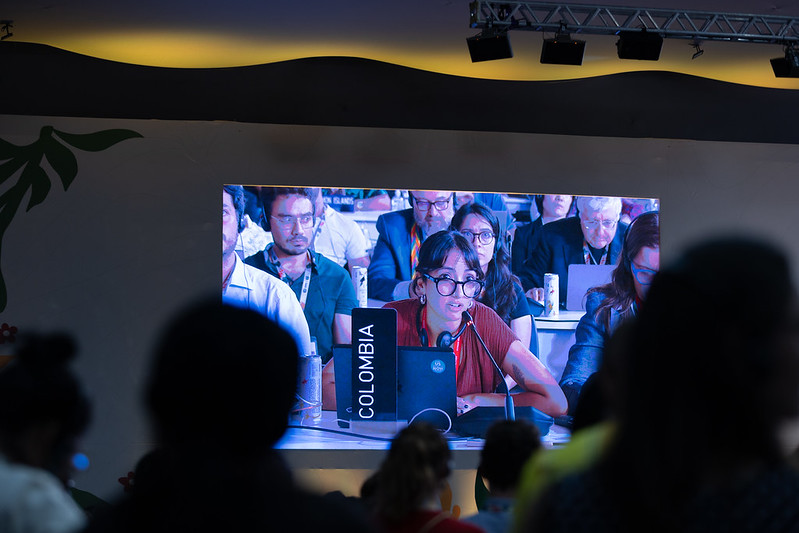

Developed countries – especially the EU – had felt isolated in their push for stronger language on emission-cutting measures after failing to win vocal support from traditional allies such as the Alliance of Small Island States (AOSIS) and the Least Developed Countries (LDCs).
That was mainly because of Europe’s inability to make a compelling offer on finance for adaptation, negotiators and observers said.
“Adaptation COP” triples finance for climate resilience
A demand from the world’s poorest nations to triple adaptation finance was agreed, but only by a deadline of 2035 rather than 2030, and without a clear number.
However, the main Mutirão decision urges developed countries to increase their collective provision of climate finance for adaptation to the Global South. It also sets up a two-year process on climate finance as well as a high-level ministerial roundtable to discuss progress towards meeting the new climate finance goal agreed last year at COP29.
That COP29 goal sets a target for rich nations to provide $300 billion a year for climate action by 2035 – and the tripling of adaptation finance decided in Belem will be part of this, as the EU had insisted.
“It is very clear that we should stand shoulder to shoulder with the poorest nations,” the EU’s climate chief Wopke Hoekstra said before the final conference session began.
Some African ministers gave the outcome on adaptation finance a cautious welcome. But many countries – including the EU, some Latin American states, Switzerland and Canada – were angry about a text that adopted indicators to measure progress on adaptation efforts.
They made interventions rejecting the decision on a new Global Goal on Adaptation (GGA) – expected to be a flagship outcome at this COP – which included a rewritten and shortened list of metrics to measure progress on climate resilience originally developed by technical experts.
Jiwoh Abdulai, environment minister of Sierra Leone, said they had worked tirelessly to craft a set of indicators that would reflect “lived realities” on the ground, but are now left with “unclear, unmeasurable and – in many cases – unusable” ones.
“For us, this is not technical, this is about our survival,” he added before the plenary was suspended.
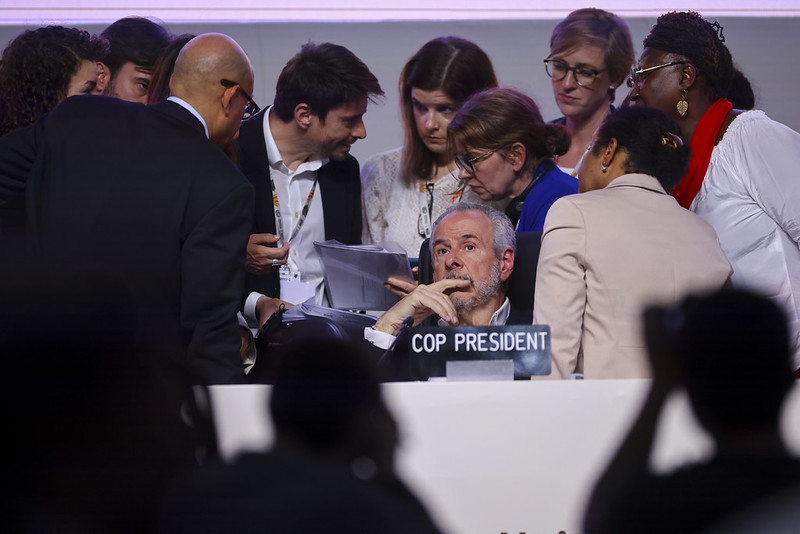

Trade and just transition land wins in Belém deal
As the Belem political package was adopted to muted applause from countries, campaigners at the back of the room whooped with joy as the conference approved a decision on just transition.
They and developing countries had swung behind a new “Belém Action Mechanism”, intended to serve as a hub to support countries in taking concrete steps to ensure their shift from dirty to clean energy systems is fair and equitable.
The Mutirão decision also includes trade, another key issue that was not on the official negotiating agenda, along with long-term climate finance and the gap in emissions-cutting ambition.
Annual dialogues will take place at the next three mid-year Bonn sessions on boosting international cooperation on trade – an emerging economy priority in the context of a carbon levy on imports proposed by the EU.
Experts said the inclusion of trade in a COP decision was a big win for China. “For the first time, trade is elevated alongside mitigation and finance as a critical third pillar for climate progress,” said Kate Logan, director of China Climate Hub at the Asia Society Policy Institute, adding that this “is likely to remain a key arena for China’s influence” in the climate regime.
The decision reaffirms that “measures taken to combat climate change, including unilateral ones, should not constitute a means of arbitrary or unjustifiable discrimination or a disguised restriction on international trade”.
The post COP30 fails to land deal on fossil fuel shift but triples finance for climate adaptation appeared first on Climate Home News.
https://www.climatechangenews.com/2025/11/22/cop30-brazil-deal-fossil-fuel-transition-fails-triples-finance-climate-adaptation/
Climate Change
COP30 fails to land deal on fossil fuel transition but triples finance for climate adaptation
After all-night talks, governments at COP30 agreed on Saturday to launch limited initiatives to strengthen emissions-cutting plans, as well as tripling finance to help poor countries cope with worsening climate change impacts by 2035. But the Amazon summit’s outcomes fell short on the global transition away from oil, gas and coal.
In an effort to deliver something on fossil fuels, the Brazilian presidency complemented the final Belém package by promising to create roadmaps on transitioning away from fossil fuels and protecting forests – as requested by Brazilian President Lula da Silva.
Brazil tabled its roadmap proposal at the eleventh hour as a compromise solution after some nations – especially European and Latin American states – voiced disappointment that a formal deal was not reached on one after strong pushback from large fossil fuel producers led by Saudi Arabia.
Brazil’s roadmap process will sit outside the UN climate regime. It will be supported by other countries such as Colombia, which is organising the first global conference on the issue, said COP30 president André Aranha Corrêa do Lago. He added that he will also craft a second roadmap to halt and reverse deforestation and report back to the COP on them both.
“We know some of you had greater ambition for some of the issues at hand,” Corrêa do Lago told a closing plenary. “I will try not to disappoint you.”
After week-long row, COP30 fails to mention fossil fuels
After more than 80 countries called for a roadmap to phase down oil, coal and gas to be kickstarted at COP30, observers said fossil fuel heavyweights, including Gulf States, Russia and India, had insisted it stay out of the final Global Mutirão decision adopted in Belém, along with any explicit mention of fossil fuels.
On Friday, the European Union and the UK had fought hard against that opposition but ultimately had to settle for two new processes that are meant to reinforce ambition and implementation of countries’ national climate plans (NDCs), with reports and a high-level dialogue due next year.
Before the final plenary, EU Climate Commissioner Wopke Hoekstra said it had been “an intense and sometimes difficult week and evening”, adding “we would have liked to have more”. But, he said, “we think we should support [the COP outcome] because at least it is going in the right direction.”
The Mutirão text encourages countries ”to strengthen their existing nationally determined contribution at any time with a view to enhancing its level of ambition” and calls on them to accelerate their implementation “while striving to do better collectively and cooperatively”.
In a last-minute push, Colombia – which championed a declaration to transition away from oil, coal and gas – told the closing plenary the country was “left with no other choice” but to object to the outcome of the dedicated mitigation track on emission-cutting efforts unless a mention to fossil fuels was added. After the presidency tried to dismiss concerns, Colombia insisted and the plenary was suspended.
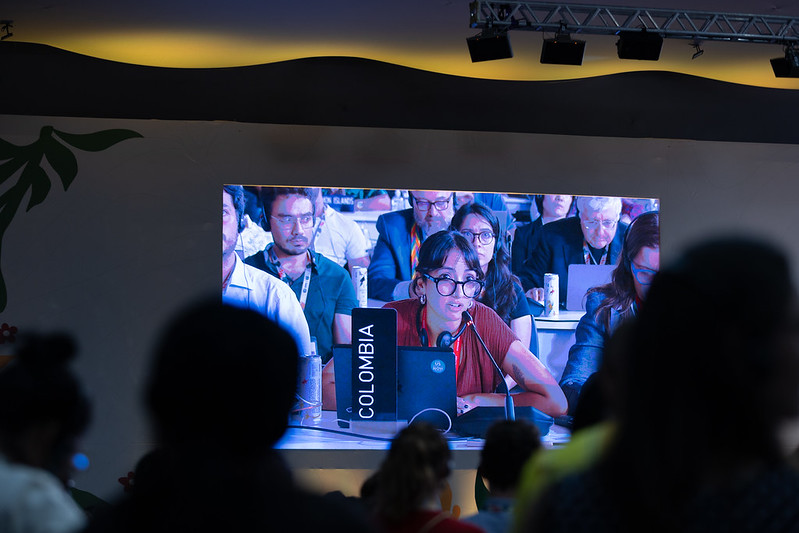

Developed countries – especially the EU – had felt isolated in their push for stronger language on emission-cutting measures after failing to win vocal support from traditional allies such as the Alliance of Small Island States (AOSIS) and the Least Developed Countries (LDCs).
That was mainly because of Europe’s inability to make a compelling offer on finance for adaptation, negotiators and observers said.
“Adaptation COP” triples finance for climate resilience
A demand from the world’s poorest nations to triple adaptation finance was agreed, but only by a deadline of 2035 rather than 2030, and without a clear number.
However, the main Mutirão decision urges developed countries to increase their collective provision of climate finance for adaptation to the Global South. It also sets up a two-year process on climate finance as well as a high-level ministerial roundtable to discuss progress towards meeting the new climate finance goal agreed last year at COP29.
That COP29 goal sets a target for rich nations to provide $300 billion a year for climate action by 2035 – and the tripling of adaptation finance decided in Belem will be part of this, as the EU had insisted.
“It is very clear that we should stand shoulder to shoulder with the poorest nations,” the EU’s climate chief Wopke Hoekstra said before the final conference session began.
Poorest countries appeal for more adaptation finance at COP30
Some African ministers gave the outcome on adaptation finance a cautious welcome. But many countries – including the EU, some Latin American states, Switzerland and Canada – were angry about a text that adopted indicators to measure progress on adaptation efforts.
They made interventions rejecting the decision on a new Global Goal on Adaptation (GGA) – expected to be a flagship outcome at this COP – which included a rewritten and shortened list of metrics to measure progress on climate resilience originally developed by technical experts.
Jiwoh Abdulai, environment minister of Sierra Leone, said they had worked tirelessly to craft a set of indicators that would reflect “lived realities” on the ground, but are now left with “unclear, unmeasurable and – in many cases – unusable” ones.
“For us, this is not technical, this is about our survival,” he added before the plenary was suspended.
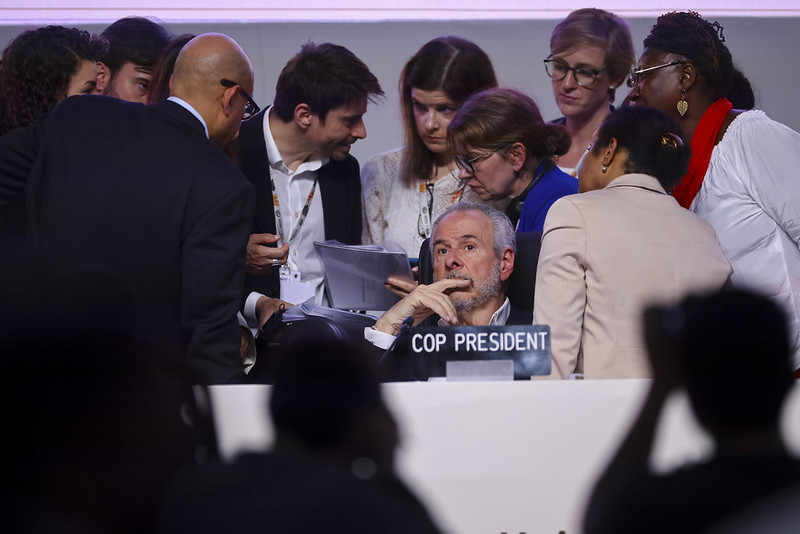

Trade and just transition land wins in Belém deal
As the Belem political package was adopted to muted applause from countries, campaigners at the back of the room whooped with joy as the conference approved a decision on just transition.
They and developing countries had swung behind a new “Belém Action Mechanism”, intended to serve as a hub to support countries in taking concrete steps to ensure their shift from dirty to clean energy systems is fair and equitable.
The Mutirão decision also includes trade, another key issue that was not on the official negotiating agenda, along with long-term climate finance and the gap in emissions-cutting ambition.
Annual dialogues will take place at the next three mid-year Bonn sessions on boosting international cooperation on trade – an emerging economy priority in the context of a carbon levy on imports proposed by the EU.
Experts said the inclusion of trade in a COP decision was a big win for China. “For the first time, trade is elevated alongside mitigation and finance as a critical third pillar for climate progress,” said Kate Logan, director of China Climate Hub at the Asia Society Policy Institute, adding that this “is likely to remain a key arena for China’s influence” in the climate regime.
The decision reaffirms that “measures taken to combat climate change, including unilateral ones, should not constitute a means of arbitrary or unjustifiable discrimination or a disguised restriction on international trade”.
The post COP30 fails to land deal on fossil fuel transition but triples finance for climate adaptation appeared first on Climate Home News.
COP30 fails to land deal on fossil fuel transition but triples finance for climate adaptation
-
Climate Change3 months ago
Guest post: Why China is still building new coal – and when it might stop
-
Greenhouse Gases3 months ago
Guest post: Why China is still building new coal – and when it might stop
-
Climate Change2 years ago
Spanish-language misinformation on renewable energy spreads online, report shows
-

 Greenhouse Gases1 year ago
Greenhouse Gases1 year ago嘉宾来稿:满足中国增长的用电需求 光伏加储能“比新建煤电更实惠”
-
Climate Change Videos2 years ago
The toxic gas flares fuelling Nigeria’s climate change – BBC News
-

 Climate Change1 year ago
Climate Change1 year ago嘉宾来稿:满足中国增长的用电需求 光伏加储能“比新建煤电更实惠”
-

 Carbon Footprint2 years ago
Carbon Footprint2 years agoUS SEC’s Climate Disclosure Rules Spur Renewed Interest in Carbon Credits
-
Renewable Energy4 months ago
US Grid Strain, Possible Allete Sale



